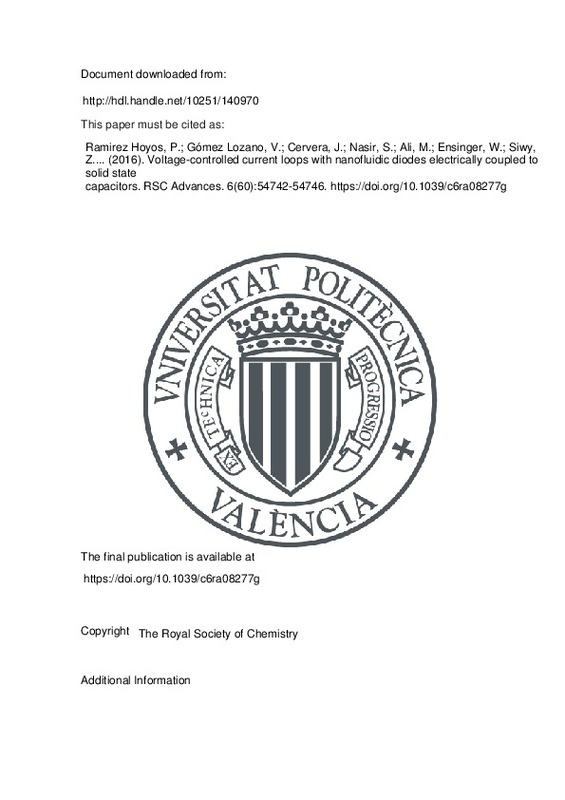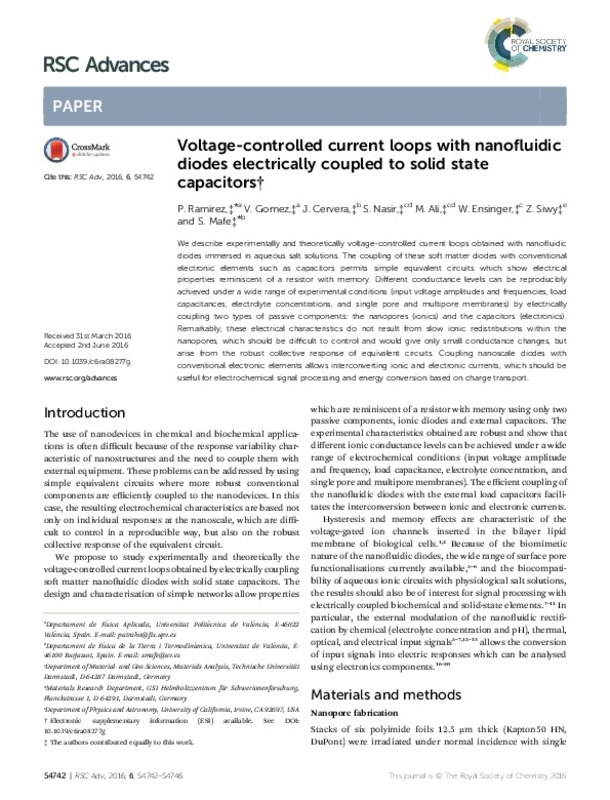JavaScript is disabled for your browser. Some features of this site may not work without it.
Buscar en RiuNet
Listar
Mi cuenta
Estadísticas
Ayuda RiuNet
Admin. UPV
Voltage-controlled current loops with nanofluidic diodes electrically coupled to solid state capacitors
Mostrar el registro sencillo del ítem
Ficheros en el ítem
| dc.contributor.author | Ramirez Hoyos, Patricio
|
es_ES |
| dc.contributor.author | Gómez Lozano, Vicente
|
es_ES |
| dc.contributor.author | Cervera, J.
|
es_ES |
| dc.contributor.author | Nasir, S.
|
es_ES |
| dc.contributor.author | Ali, M.
|
es_ES |
| dc.contributor.author | Ensinger, W.
|
es_ES |
| dc.contributor.author | Siwy, Z.
|
es_ES |
| dc.contributor.author | Mafe, S.
|
es_ES |
| dc.date.accessioned | 2020-04-17T12:52:02Z | |
| dc.date.available | 2020-04-17T12:52:02Z | |
| dc.date.issued | 2016 | es_ES |
| dc.identifier.uri | http://hdl.handle.net/10251/140970 | |
| dc.description.abstract | [EN] We describe experimentally and theoretically voltage-controlled current loops obtained with nanofluidic diodes immersed in aqueous salt solutions. The coupling of these soft matter diodes with conventional electronic elements such as capacitors permits simple equivalent circuits which show electrical properties reminiscent of a resistor with memory. Different conductance levels can be reproducibly achieved under a wide range of experimental conditions (input voltage amplitudes and frequencies, load capacitances, electrolyte concentrations, and single pore and multipore membranes) by electrically coupling two types of passive components: the nanopores (ionics) and the capacitors (electronics). Remarkably, these electrical characteristics do not result from slow ionic redistributions within the nanopores, which should be difficult to control and would give only small conductance changes, but arise from the robust collective response of equivalent circuits. Coupling nanoscale diodes with conventional electronic elements allows interconverting ionic and electronic currents, which should be useful for electrochemical signal processing and energy conversion based on charge transport. | es_ES |
| dc.description.sponsorship | Support from the Ministry of Economic Affairs and Competitiveness and FEDER (project MAT2015-65011-P), the Generalitat Valenciana (project Prometeo/GV/0069 for Groups of Excellence). M. A, S. N. and W. E acknowledge the funding from the Hessen State Ministry of Higher Education, Research and the Arts, Germany, in the frame of LOEWE project iNAPO. Z. S. acknowledges the funding from the National Science Foundation (CHE 1306058). | es_ES |
| dc.language | Inglés | es_ES |
| dc.publisher | The Royal Society of Chemistry | es_ES |
| dc.relation.ispartof | RSC Advances | es_ES |
| dc.rights | Reserva de todos los derechos | es_ES |
| dc.subject.classification | FISICA APLICADA | es_ES |
| dc.title | Voltage-controlled current loops with nanofluidic diodes electrically coupled to solid state capacitors | es_ES |
| dc.type | Artículo | es_ES |
| dc.identifier.doi | 10.1039/c6ra08277g | es_ES |
| dc.relation.projectID | info:eu-repo/grantAgreement/GVA//PROMETEO%2FGV%2F0069 | es_ES |
| dc.relation.projectID | info:eu-repo/grantAgreement/NSF//1306058/US/Nanoporous ionic circuits and ionic mimic of a neuron/ | es_ES |
| dc.relation.projectID | info:eu-repo/grantAgreement/MINECO//MAT2015-65011-P/ES/NANOFLUIDICA DE POROS BIOMIMETICOS: NUEVAS APLICACIONES EN CONVERSION DE ENERGIA Y SENSORES%2FACTUADORES/ | es_ES |
| dc.rights.accessRights | Abierto | es_ES |
| dc.contributor.affiliation | Universitat Politècnica de València. Departamento de Física Aplicada - Departament de Física Aplicada | es_ES |
| dc.description.bibliographicCitation | Ramirez Hoyos, P.; Gómez Lozano, V.; Cervera, J.; Nasir, S.; Ali, M.; Ensinger, W.; Siwy, Z.... (2016). Voltage-controlled current loops with nanofluidic diodes electrically coupled to solid state capacitors. RSC Advances. 6(60):54742-54746. https://doi.org/10.1039/c6ra08277g | es_ES |
| dc.description.accrualMethod | S | es_ES |
| dc.relation.publisherversion | https://doi.org/10.1039/c6ra08277g | es_ES |
| dc.description.upvformatpinicio | 54742 | es_ES |
| dc.description.upvformatpfin | 54746 | es_ES |
| dc.type.version | info:eu-repo/semantics/publishedVersion | es_ES |
| dc.description.volume | 6 | es_ES |
| dc.description.issue | 60 | es_ES |
| dc.identifier.eissn | 2046-2069 | es_ES |
| dc.relation.pasarela | S\314421 | es_ES |
| dc.contributor.funder | Generalitat Valenciana | es_ES |
| dc.contributor.funder | National Science Foundation, EEUU | es_ES |
| dc.contributor.funder | European Regional Development Fund | es_ES |
| dc.contributor.funder | Hessisches Ministerium für Wissenschaft und Kunst, Alemania | es_ES |
| dc.contributor.funder | Ministerio de Economía, Industria y Competitividad | es_ES |
| dc.description.references | Fologea, D., Krueger, E., Mazur, Y. I., Stith, C., Okuyama, Y., Henry, R., & Salamo, G. J. (2011). Bi-stability, hysteresis, and memory of voltage-gated lysenin channels. Biochimica et Biophysica Acta (BBA) - Biomembranes, 1808(12), 2933-2939. doi:10.1016/j.bbamem.2011.09.005 | es_ES |
| dc.description.references | Pustovoit, M. A., Berezhkovskii, A. M., & Bezrukov, S. M. (2006). Analytical theory of hysteresis in ion channels: Two-state model. The Journal of Chemical Physics, 125(19), 194907. doi:10.1063/1.2364898 | es_ES |
| dc.description.references | Ramirez, P., Cervera, J., Ali, M., Ensinger, W., & Mafe, S. (2014). Logic Functions with Stimuli-Responsive Single Nanopores. ChemElectroChem, 1(4), 698-705. doi:10.1002/celc.201300255 | es_ES |
| dc.description.references | Martin, C. R., & Siwy, Z. S. (2007). CHEMISTRY: Learning Nature’s Way: Biosensing with Synthetic Nanopores. Science, 317(5836), 331-332. doi:10.1126/science.1146126 | es_ES |
| dc.description.references | Hou, X., & Jiang, L. (2009). Learning from Nature: Building Bio-Inspired Smart Nanochannels. ACS Nano, 3(11), 3339-3342. doi:10.1021/nn901402b | es_ES |
| dc.description.references | Zhang, H., Tian, Y., & Jiang, L. (2016). Fundamental studies and practical applications of bio-inspired smart solid-state nanopores and nanochannels. Nano Today, 11(1), 61-81. doi:10.1016/j.nantod.2015.11.001 | es_ES |
| dc.description.references | Chun, H., & Chung, T. D. (2015). Iontronics. Annual Review of Analytical Chemistry, 8(1), 441-462. doi:10.1146/annurev-anchem-071114-040202 | es_ES |
| dc.description.references | Tagliazucchi, M., & Szleifer, I. (2015). Transport mechanisms in nanopores and nanochannels: can we mimic nature? Materials Today, 18(3), 131-142. doi:10.1016/j.mattod.2014.10.020 | es_ES |
| dc.description.references | Misra, N., Martinez, J. A., Huang, S.-C. J., Wang, Y., Stroeve, P., Grigoropoulos, C. P., & Noy, A. (2009). Bioelectronic silicon nanowire devices using functional membrane proteins. Proceedings of the National Academy of Sciences, 106(33), 13780-13784. doi:10.1073/pnas.0904850106 | es_ES |
| dc.description.references | Senapati, S., Basuray, S., Slouka, Z., Cheng, L.-J., & Chang, H.-C. (2011). A Nanomembrane-Based Nucleic Acid Sensing Platform for Portable Diagnostics. Topics in Current Chemistry, 153-169. doi:10.1007/128_2011_142 | es_ES |
| dc.description.references | Haywood, D. G., Saha-Shah, A., Baker, L. A., & Jacobson, S. C. (2014). Fundamental Studies of Nanofluidics: Nanopores, Nanochannels, and Nanopipets. Analytical Chemistry, 87(1), 172-187. doi:10.1021/ac504180h | es_ES |
| dc.description.references | Pérez-Mitta, G., Tuninetti, J. S., Knoll, W., Trautmann, C., Toimil-Molares, M. E., & Azzaroni, O. (2015). Polydopamine Meets Solid-State Nanopores: A Bioinspired Integrative Surface Chemistry Approach To Tailor the Functional Properties of Nanofluidic Diodes. Journal of the American Chemical Society, 137(18), 6011-6017. doi:10.1021/jacs.5b01638 | es_ES |
| dc.description.references | Ali, M., Nasir, S., Ramirez, P., Ahmed, I., Nguyen, Q. H., Fruk, L., … Ensinger, W. (2011). Optical Gating of Photosensitive Synthetic Ion Channels. Advanced Functional Materials, 22(2), 390-396. doi:10.1002/adfm.201102146 | es_ES |
| dc.description.references | Ali, M., Nasir, S., Ramirez, P., Cervera, J., Mafe, S., & Ensinger, W. (2013). Carbohydrate-Mediated Biomolecular Recognition and Gating of Synthetic Ion Channels. The Journal of Physical Chemistry C, 117(35), 18234-18242. doi:10.1021/jp4054555 | es_ES |
| dc.description.references | Ali, M., Ahmed, I., Nasir, S., Ramirez, P., Niemeyer, C. M., Mafe, S., & Ensinger, W. (2015). Ionic Transport through Chemically Functionalized Hydrogen Peroxide-Sensitive Asymmetric Nanopores. ACS Applied Materials & Interfaces, 7(35), 19541-19545. doi:10.1021/acsami.5b06015 | es_ES |
| dc.description.references | Albrecht, T. (2011). How to Understand and Interpret Current Flow in Nanopore/Electrode Devices. ACS Nano, 5(8), 6714-6725. doi:10.1021/nn202253z | es_ES |
| dc.description.references | Lemay, S. G. (2009). Nanopore-Based Biosensors: The Interface between Ionics and Electronics. ACS Nano, 3(4), 775-779. doi:10.1021/nn900336j | es_ES |
| dc.description.references | Gomez, V., Ramirez, P., Cervera, J., Nasir, S., Ali, M., Ensinger, W., & Mafe, S. (2015). Charging a Capacitor from an External Fluctuating Potential using a Single Conical Nanopore. Scientific Reports, 5(1). doi:10.1038/srep09501 | es_ES |
| dc.description.references | Ramirez, P., Gomez, V., Cervera, J., Nasir, S., Ali, M., Ensinger, W., & Mafe, S. (2015). Energy conversion from external fluctuating signals based on asymmetric nanopores. Nano Energy, 16, 375-382. doi:10.1016/j.nanoen.2015.07.013 | es_ES |
| dc.description.references | Tybrandt, K., Forchheimer, R., & Berggren, M. (2012). Logic gates based on ion transistors. Nature Communications, 3(1). doi:10.1038/ncomms1869 | es_ES |
| dc.description.references | Apel, P. (2001). Track etching technique in membrane technology. Radiation Measurements, 34(1-6), 559-566. doi:10.1016/s1350-4487(01)00228-1 | es_ES |
| dc.description.references | Cervera, J., Schiedt, B., Neumann, R., Mafé, S., & Ramírez, P. (2006). Ionic conduction, rectification, and selectivity in single conical nanopores. The Journal of Chemical Physics, 124(10), 104706. doi:10.1063/1.2179797 | es_ES |
| dc.description.references | Ali, M., Ramirez, P., Mafé, S., Neumann, R., & Ensinger, W. (2009). A pH-Tunable Nanofluidic Diode with a Broad Range of Rectifying Properties. ACS Nano, 3(3), 603-608. doi:10.1021/nn900039f | es_ES |
| dc.description.references | Ramirez, P., Gomez, V., Verdia-Baguena, C., Nasir, S., Ali, M., Ensinger, W., & Mafe, S. (2016). Designing voltage multipliers with nanofluidic diodes immersed in aqueous salt solutions. Physical Chemistry Chemical Physics, 18(5), 3995-3999. doi:10.1039/c5cp07203d | es_ES |
| dc.description.references | Wang, D., Kvetny, M., Liu, J., Brown, W., Li, Y., & Wang, G. (2012). Transmembrane Potential across Single Conical Nanopores and Resulting Memristive and Memcapacitive Ion Transport. Journal of the American Chemical Society, 134(8), 3651-3654. doi:10.1021/ja211142e | es_ES |
| dc.description.references | Momotenko, D., & Girault, H. H. (2011). Scan-Rate-Dependent Ion Current Rectification and Rectification Inversion in Charged Conical Nanopores. Journal of the American Chemical Society, 133(37), 14496-14499. doi:10.1021/ja2048368 | es_ES |
| dc.description.references | Zhang, A., & Lieber, C. M. (2015). Nano-Bioelectronics. Chemical Reviews, 116(1), 215-257. doi:10.1021/acs.chemrev.5b00608 | es_ES |









